When you first think of the Republic of Ireland, you may think of vast green landscapes, Celtic folklore and of the fine array of cultural exports that stem from the Emerald Isle. There’s no doubt it is one of the most unique and fascinating countries in Europe.
And, in Ireland’s cities and towns, you can find innovative architecture that originates as far back as the Stone Age, and spans the Georgian, Gothic and modern eras.
Amongst this architectural petri dish is a selection of tall buildings that have either lasted through the centuries, been completed in the modern period, or are in the process of being built. These can be found in urban centres across the country, from Limerick and Cork to the capital Dublin.
So, without further ado, here is our list of the top 21+ tallest buildings in Ireland, featuring both proposed and completed buildings. Please note, for this list, we’re not including uninhabitable structures, such as monuments, chimneys and transmitters.
1. AquaVetro Tower, Dublin
Height: 289 feet
Status: Proposed
Completion: TBC
Type of building: Office
Dublin, and Ireland as a whole, may be about to have a new tallest building! The AquaVetro Tower in Dublin is a proposed new grade A office building on the banks of the River Liffey. 22 storeys high and boasting panoramic views of the city, this sleek new building will offer restaurants, cafes and gyms within its premises.
Works were given the go ahead in 2019 but, at the time of writing, no news has been offered about when this development will complete. Regardless of when the completion date is, Dublin is sure to have a new riverside landmark when this tower reaches its pinnacle.
2. Capital Dock, Dublin

Height: 259 feet
Status: Completed
Completion: 2018
Type of building: Mixed use Development
At 22 storeys high, Capital Dock in Dublin’s Docklands district is a modern addition for the Irish capital. It is a mixed use development that comprises retail lots, apartments and amenities such as gyms. Located where the Sir John Rogerson’s Quay & Britain Quay meet, it is made of all concrete and first began construction in 2014.
Built on a large patch of undeveloped land next to the River Liffey, the site was once proposed to be the site of a skyscraper called U2 Tower. However, this fell through, and instead, Ireland has a new urban quarter to enjoy.
3. The EXO, Dublin
Height: 240 feet
Status: Completed
Completion: 2021
Type of building: Office
Situated in Dublin’s North Wall district, the EXO building is one of Ireland’s newest tall buildings. It forms part of Point Village: an €800 million commercial and residential development built next to the North Wall Quay.
The name ‘EXO’ refers to the term ‘exoskeleton’, which in turn reflects the visual landscape of the many cranes and gantries of the local port area. At 73 metres tall, it is the highest office building in the Republic of Ireland.
4. The Elysian, Cork

Height: 233 feet
Status: Completed
Completion: 2008
Type of building: Mixed use Development
The Elysian Tower in Cork comprises a number of six to eight storey buildings, with a 68 metre high tower as its focal point. Alongside 211 residential flats, this building includes features such as a supermarket, basement garage and even a Japanese garden.
Construction and development of this tower has not been without controversy. At one point it was colloquially referred to as ‘The Idle Tower’ due to its low vacancy rates. However, this has largely been resolved at the time of writing.
5. John’s Lane Church, Dublin
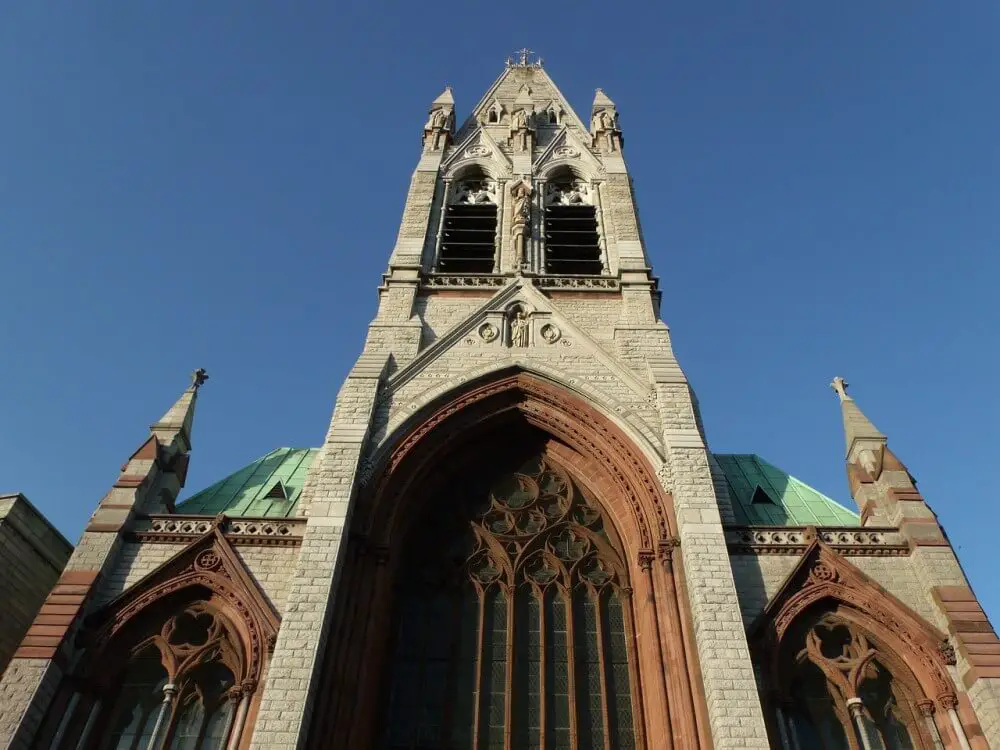
Spire height: 230 feet
Status: Completed
Completion: 1911
Type of building: Church
Dublin’s tallest church, with a full height of 230 feet, is John’s Lane Church at 94-96 Thomas Street. It is a large Roman Catholic church that was built to replace the medieval St. John’s Hospital, with groundbreaking taking place in 1862.
Ever since its opening in 1874, and its full completion in 1911, the Church has wowed visitors with its Gothic revival architecture and intricately decorated interior. The ten bells that are stored in the Church’s tower are rung once a month.
6. County Hall, Cork
Height: 220 feet
Status: Completed
Completion: 1968
Type of building: Office/Civic building
Cork County Hall, at 243 feet high, was once the tallest habitable building in the whole of Ireland. Despite the fact it has now been passed in height by other structures, it still stands out clearly above the rest of Cork.
It was originally completed in 1968, when it housed the offices of Cork County Council. A 2002 redevelopment project sought to add another storey to the tower, rejuvenate the facade and add a six storey extension to the side. This was finished in 2006.
7. Google Docks, Dublin
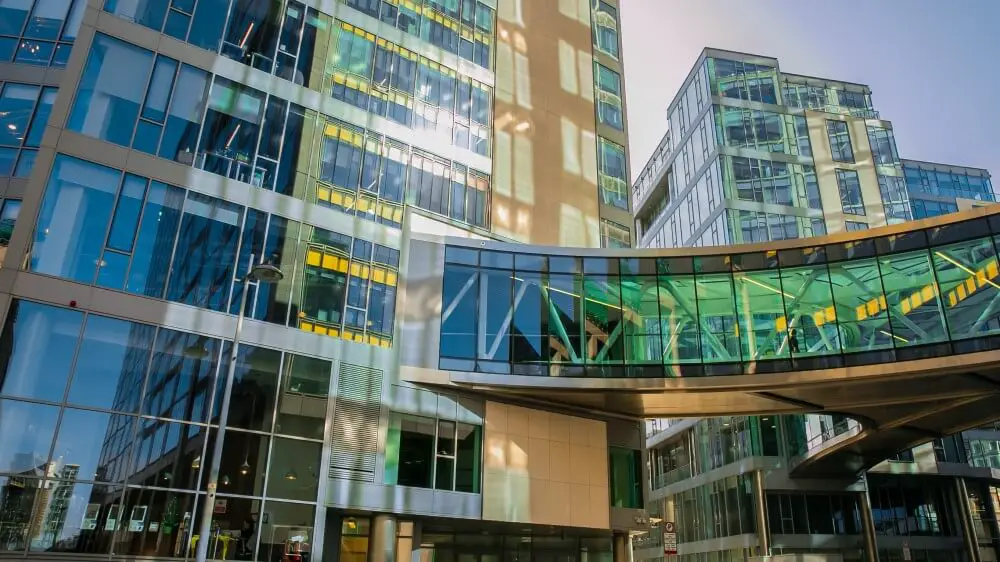
Height: 220 feet
Status: Completed
Completion: 2010
Type of building: Office
Google Docks, otherwise known as the Montevetro Building, is located on Barrow Street, Dublin, and since 2011 has been the home to tech giant Google. At 67 metres, it is a bulky addition to the Grand Canal Dock, particularly with the striking black and yellow cladding that marks its exterior.
Since its completion, Google has designed and constructed a new footbridge to its other offices across Barrow Street. This now stands alongside the existing gyms and restaurants of Google Docks as a great way to accommodate workers and visitors.
8. St. Patrick’s Cathedral, Dublin
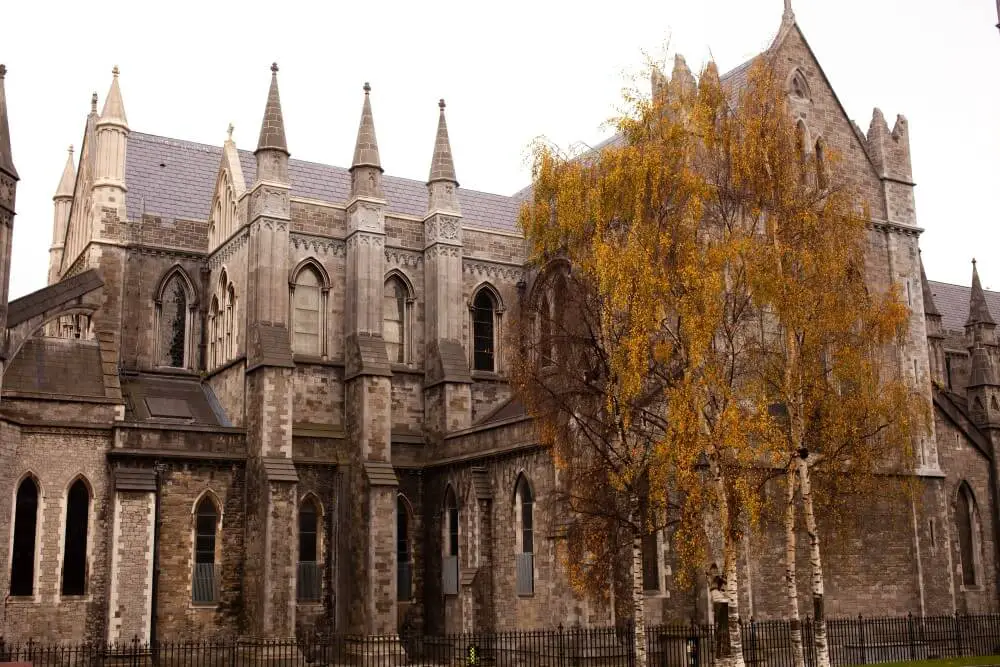
Spire height: 218 feet
Status: Completed
Completion: 1191
Type of building: Cathedral
Founded in 1191, Saint Patrick’s Cathedral is one of the historical marvels of Dublin. At present, it is the national cathedral of the Church of Ireland, and, unusually for any city, it is one of two cathedrals in Dublin that belong to the same church.
Aside from its historical and religious importance, Saint Patrick’s Cathedral is also a visually impressive sight, with a spire height rising to 218 feet. It was built in the early English gothic style, and features heavy buttressing in its interior to help maintain the building’s cruciform shape.
9. Millennium Tower, Dublin
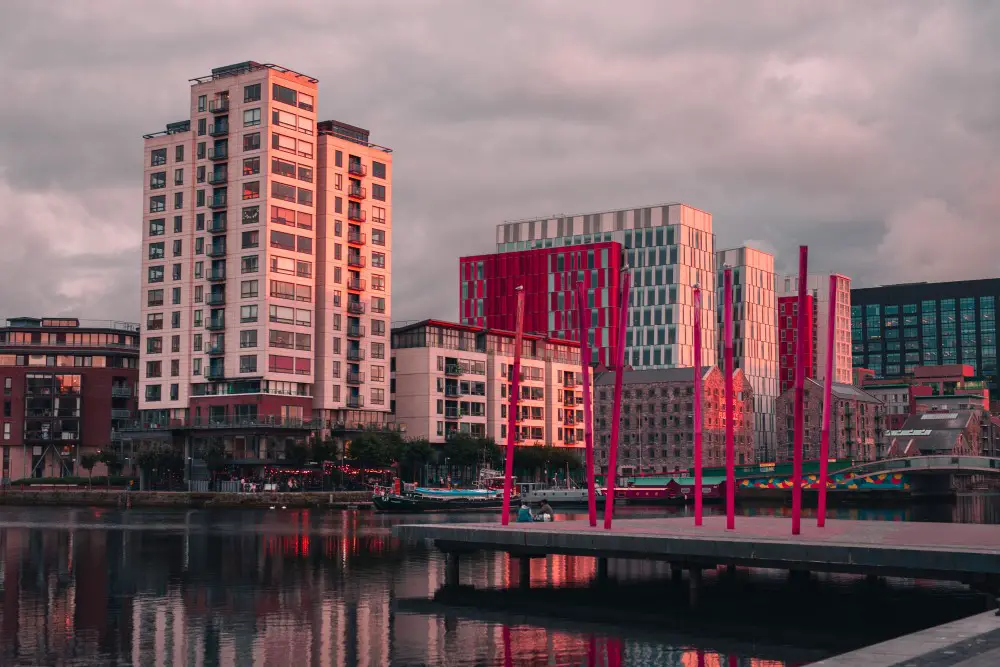
Height: 207 feet
Status: Completed
Completion: 1998
Type of building: Mixed use Development
As part of the new wave of tall buildings earmarked for the Irish capital at the turn of the 21st Century, Millennium Tower spearheaded the rejuvenation of Dublin’s Docklands district. Standing 207 feet tall, the tower contains 242 apartments, as well as 800 square feet of office and retail space.
Otherwise known as the Charlotte Quay Apartments, the Millennium Tower is located right next to the Charlotte Quay Dock, offering panoramic waterside views. In recognition of its architectural merits, the tower was selected as one of the Irish entries for the Mies Van der Rohe Prize in 1999.
10. St. George’s Church, Dublin
Spire height: 200 feet
Status: Completed
Completion: 1802
Type of building: Church/Office
St. George’s Church in Dublin is considered one of architect Francis Johnston’s greatest pieces of work. It was built in the architectural style of both Gothic and Greek revival, and closely resembles London’s St-Martin-in-the-Fields parish church.
This storied church, which makes an appearance in the epic novel Ulysses, has a lively past, but unfortunately this was not enough to save it from closure. In 1990, due to falling congregation numbers and rising costs, it was closed down. In the years since, it has served as a theatre, a night club, and now exists primarily as an office space.
11. Liberty Hall, Dublin
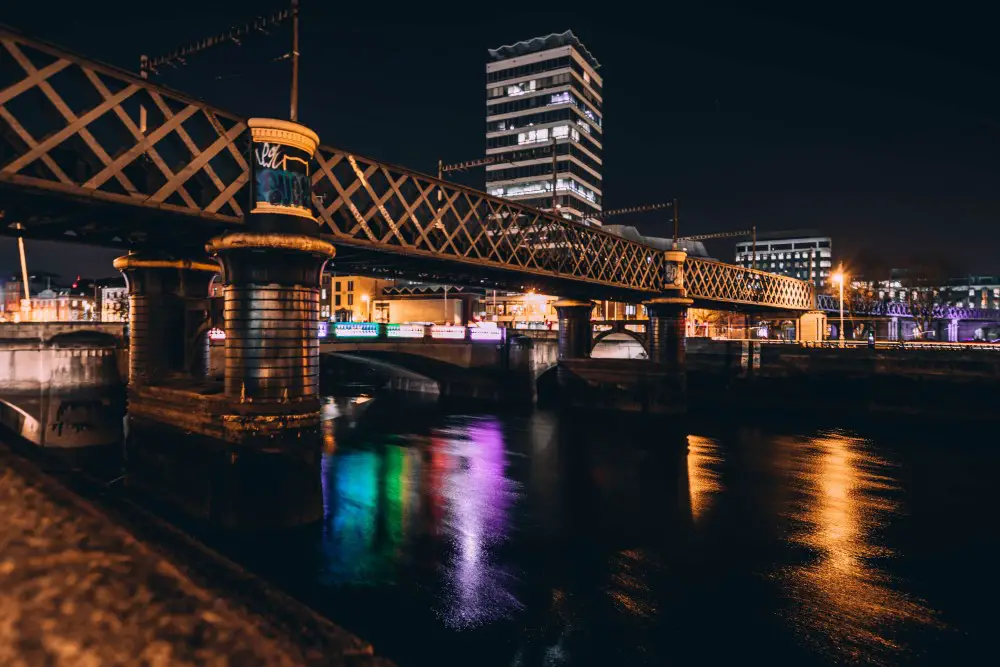
Height: 195 feet
Status: Completed
Completion: 1965
Type of building: Theatre
The Liberty Hall building in Dublin stood for a long time as Ireland’s tallest office building, until turn-of-the-century developments took its crown. Completed in 1965 in a modernist style, the viewing deck on the top floor makes for a spectacular view of the adjacent River Liffey and wider city.
Liberty Hall was built on the site of the former headquarters of the Irish Citizen Army (ICA), which was where the 1916 Easter Rising was planned. Today, it is the headquarters of the Services, Industrial, Professional, and Technical Union (SIPTU).
12. Riverpoint, Limerick
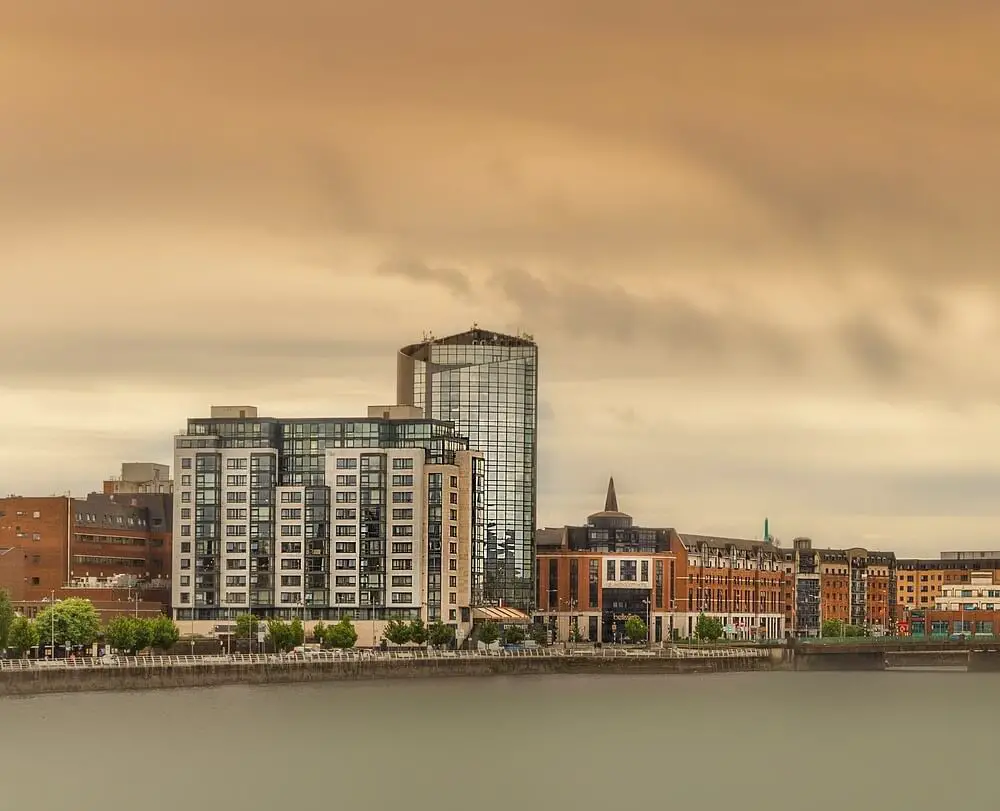
Height: 194 feet
Status: Completed
Completion: 2008
Type of building: Mixed use Development
The Riverpoint development in Limerick represents one of Munster’s tallest buildings. Standing at 194 feet tall, it features a wide range of buildings, including restaurants, offices and 137 apartments.
Groundbreaking for Riverpoint began in 2005, and full building work was completed in 2008. It replaced St. Munchin’s House, which was once described unflatteringly as one of the ugliest buildings in Limerick.
13. One George’s Quay Plaza, Dublin
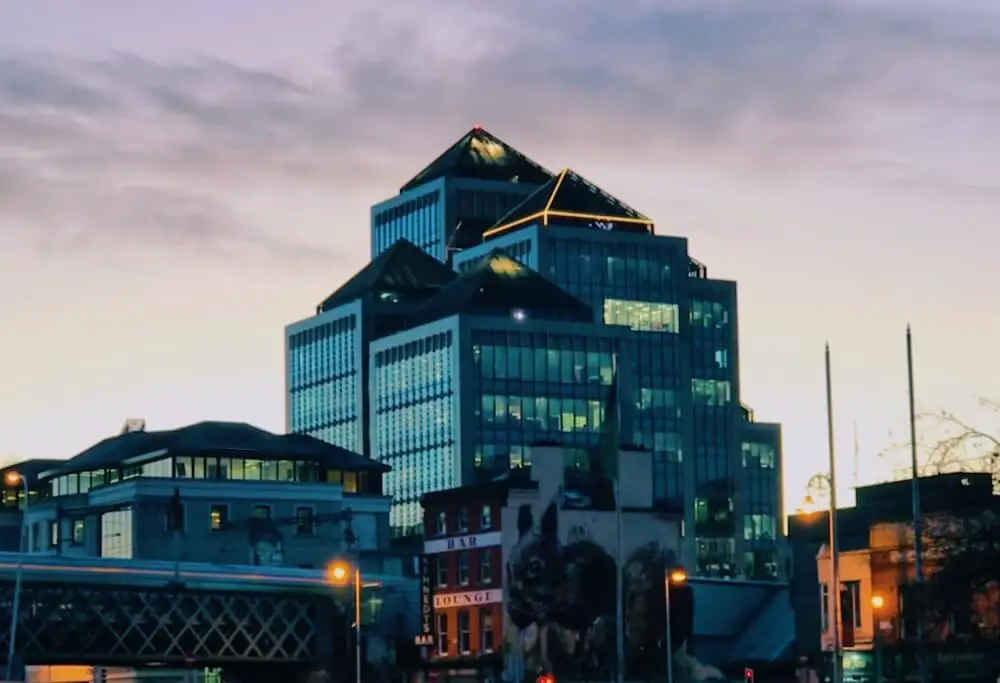
Height: 193 feet
Status: Completed
Completion: 2002
Type of building: Office
One George’s Quay Plaza is a 193 foot high tower located in Dublin’s Docklands district. It stands close to Tara Street train station, and forms part of the city’s wider George’s Quay Plaza scheme. Since its opening, it has become the Irish headquarters of both Facebook and Ulster Bank.
Plans for this scheme date back to the 1980s, and the full scheme was finally completed in 2002. Such is the similarity with the George’s Quay Plaza development to London’s Canary Wharf that this set of buildings has been informally called ‘Canary Dwarf’.
14. Crowne Plaza, Dundalk
Height: 190 feet
Status: Completed
Completion: 2008
Type of building: Hotel
County Louth’s tallest building is the 14 storey high Crowne Plaza Hotel in Dundalk. This modernist tower and its connected developments were designed as a gateway to greet visitors coming into Dundalk from the South.
Not only can you expect fabulous views of the town of Dundalk and the surrounding countryside at Crowne Plaza. Now, it also features the tallest mural in Ireland, thanks to an amazing piece of work carried out by renowned artist Sam Bates in 2021.
15. Clayton Hotel, Limerick
Height: 187 feet
Status: Completed
Completion: 2002
Type of building: Hotel
Clayton Hotel in Limerick, formerly known as the Clarion Hotel, stands high on the banks of the River Shannon as the city’s second tallest building. Ever since opening its doors in 2002, it has offered guests amazing views of the city and the surrounding area.
In total, Clayton Hotel comprises 158 rooms, 3 suites and a penthouse, with the latter promising the most stunning views. It also features a pool, sauna and a steam room.
16. Abbey Presbyterian Church, Dublin
Spire height: 180 feet
Status: Completed
Completion: 1864
Type of building: Church
Located next to the Dublin Writers Museum, Abbey Presbyterian Church in Dublin is a Gothic style church that was founded in 1864. With a spire height of 180 feet, it is the third-highest church in Ireland.
This intricately decorated structure was designed by Scottish architect Andrew Heiton, and funded in large part by a prominent Dublin merchant named Alexander Findlater. This is the reason why the Church is sometimes referred to as ‘Findlater’s Church’.
17. Metro Hotel Dublin Airport, Dublin
Height: 173 feet
Status: Completed
Completion: 2006
Type of building: Hotel
Hosting visitors from all corners of the world, Metro Hotel at Dublin Airport is located close to Dublin Airport’s southern perimeter. It was designed by Shay Cleary Architects, and opened its doors for the first time in 2006.
At 173 feet tall, it makes the list as one of Ireland’s tallest buildings.
18. Alto Vetro, Dublin

Height: 168 feet
Status: Completed
Completion: 2009
Type of building: Apartments
Rising 16 storeys into the Dublin sky, Alto Vetro is a residential tower that lies close to MacMahon Bridge. It overlooks the Grand Canal Docks and is one of an array of tall buildings that have rejuvenated the Docklands area of Dublin.
Developed by Shay Cleary Architects, the Alto Vetro complex contains 26 apartments, a coffee shop and a barbers. In 2008, it was awarded the Royal Institute of the Architects of Ireland’s (RIAI) Silver Medal for Housing.
19. Central Plaza, Dublin
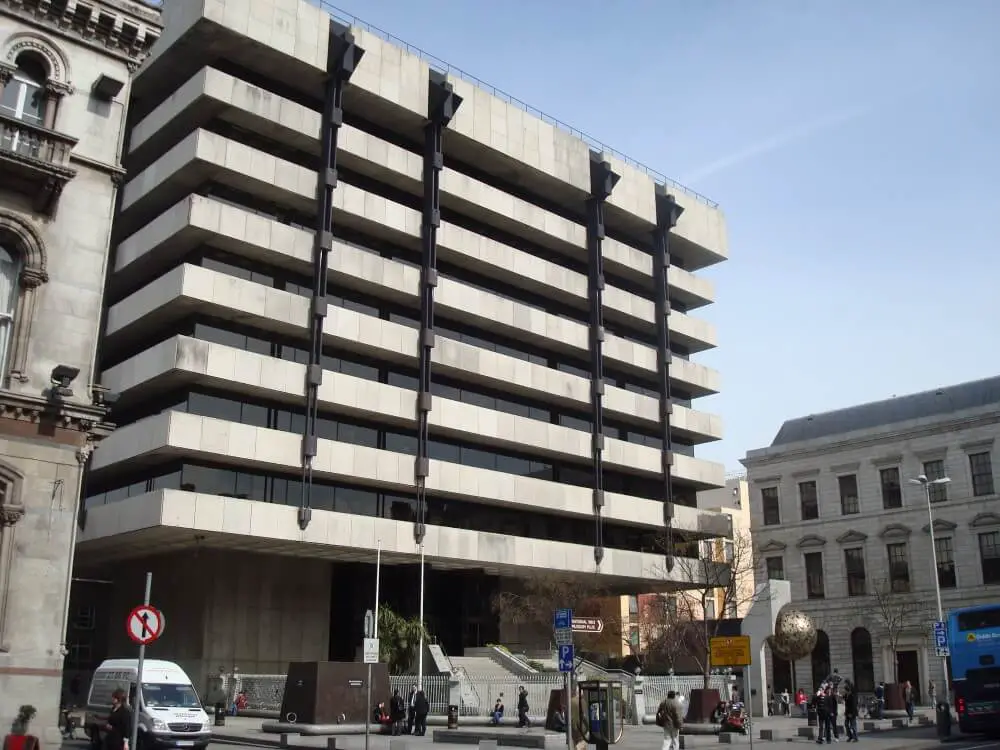
Height: 147 feet
Status: Completed
Completion: 1978
Type of building: Office
Central Plaza, located in the heart of Dublin, was for a long time known as the headquarters of the Central Bank of Ireland. This changed in 2017, when the organisation moved to a new building in the Docklands district.
The building’s brutalist architecture and substantial height, at 147 feet, was controversial at the time of construction. It was generally felt to be out of touch with the surrounding urban environment, especially when the building topped out higher than was originally proposed.
In 2020, a series of renovations have modernised Central Plaza, adding a rooftop observation deck and events venue.
20. O’Connell Bridge House, Dublin

Height: 144 feet
Status: Completed
Completion: 1965
Type of building: Office
Completed in 1965, O’Connell Bridge House in the East of Dublin was built for a grand sum of 1 million Irish pounds. At 12 storeys high, it was one of Ireland’s very tallest buildings when work finished.
The construction of this concrete and glass tower, alongside Liberty Hall, heralded a new era for Irish architecture. It is sometimes referred to as the Heineken Building, due to the large advertising lettering that adorns the facade.
21. The Tower Block, Smithfield Square, Dublin
Height: 138 metres
Status: Completed
Completion: 2011
Type of building: Apartments
The main apartment block of the Smithfield Market redevelopment makes its way onto the list of tallest buildings in Ireland thanks to its 138-metre-height.
The Smithfield scheme in general was intended to deliver a new urban quarter for Dublin, with 120,000 square metres earmarked for mixed use, including retail, restaurants, workshops and more. This project, including its main tower block, finished in 2011.
We hope you’ve enjoyed our guide to the tallest buildings in the Republic of Ireland. Judging by the amount of recent developments on this list, it’s clear to see that the Emerald Isle is increasingly reaching for the sky with its architectural ambitions.
For more compilations, building news and architectural discussion, explore our latest articles, including why a building is called a building if it has already been built.
Or, for more general definitions and vocabulary explanations from the world of architecture, take a look at our selection of Building Wikis.
Last Updated on 12 February 2023 by Michael